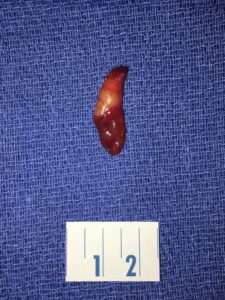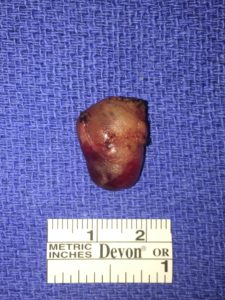Primary Hyperparathyroidism
Primary hyperparathyroidism is appropriately named, as it indicates a problem which starts in one or more of the parathyroid glands. It is by far the most common disorder which occurs with the parathyroid glands. It occurs when one or more of the parathyroid glands develops a benign growth called an adenoma, which secretes too much parathyroid hormone into the bloodstream. Nobody knows what causes them to grow. Though these growths are benign, the elevated parathyroid hormone secretion affects the body in many detrimental ways.


The largest supply of calcium is in your bones. When parathyroid hormone levels are inappropriately elevated, the body then takes calcium from the bones and places it into the bloodstream. This may be detected with calcium levels consistently above 10 on routine bloodwork. Early on this process is asymptomatic, but over time a patient with this condition experiences this bone breakdown as pain in their bones and joints. Often times this is incorrectly diagnosed as ordinary arthritis, and if observation continues, osteoporosis will develop at a young age. High blood calcium itself causes vague symptoms such as fatigue, memory problems, and abdominal pains. Calcium is normally excreted through the kidneys, and elevated calcium in the blood takes a toll here as well. Kidney stones develop from the kidneys being force to filter too much calcium from the bloodstream. As anyone who has had a kidney stone will tell you, they are very uncomfortable to pass, and even more uncomfortable to have removed (especially if you end up with a stent).
Secondary Hyperparathyroidism
Secondary hyperparathyroidism is a physiologic elevation of PTH, and does not indicate a problem which started with the parathyroid glands themselves. The most common cause of secondary hyperparathyroidism is vitamin D deficiency, where the parathyroid hormone level is elevated in the setting of a normal calcium level. Vitamin D helps the body absorb calcium through the intestines. When it is low, the intestines cannot absorb enough calcium to maintain the blood calcium level, so PTH elevates to draw some calcium out of the bones and into the blood. Parathyroid glands should never be removed for this condition, as they are functioning appropriately. With vitamin D supplementation, this condition will normalize on its own.
Another form of secondary hyperparathyroidism occurs in patients with renal failure who are on dialysis. This again is a physiologic response to calcium wasting which occurs during dialysis, and like Vitamin D deficiency, the calcium levels will be normal but the PTH may be elevated into the thousands. The cure for this condition is renal transplantation, or medical management until transplant occurs. Surgery is sometimes performed for patients who are having significant bone disorders and not candidates for renal transplantation.
Tertiary Hyperparathyroidism
Tertiary hyperparathyroidism occurs when one or more parathyroid gland which were hyperfunctioning in a patient on dialysis continue to hyperfunction one year after successful renal transplant. It is approached much like primary hyperparathyroidism, and surgery is the treatment of choice.
Hypoparathyroidism
Hypoparathyroidism means that there is insufficient parathyroid hormone production, and fortunately this most often a temporary condition. This can occur after having a total thyroidectomy or a parathyroidectomy, where the parathyroid glands are stunned during the operation. If this occurs, additional calcium and vitamin D supplementation must be given until the function of the parathyroid glands returns. This usually takes a few weeks, but may take several months. If parathyroid function never returns, the condition is called permanent hypoparathyroidism and this must be treated with daily calcium and vitamin D supplementation. There is artificial parathyroid hormone available, but this requires multiple injections on a daily basis. Fortunately, this condition is extremely rare (<0.5%) in the hands of experienced surgeons. There are congenital forms of hypoparathyroidism which occur with genetic abnormalities of the 22nd chromosome, but again these are rare and occur with syndromes such as DiGeorge syndrome and Velocardiofacial syndrome which are diagnosed vey early in life.
